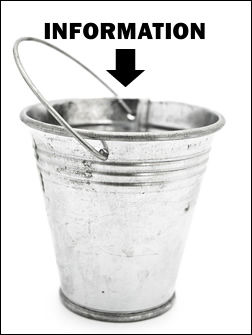
The game of chess and the practice of mind mapping have much in common: Both use visual “artifacts” as instruments to tell us the relationship between the pieces. Dave Gray, Sunni Brown and James Macanufo, authors of the book Gamestorming: A Playbook for Innovators, Rulebreakers and Changemakers, explain:
“In knowledge work, an artifact is any tangible, portable object that holds information. An artifact can be anything from a piece of paper to a sticky note or index card. Artifacts make it easier to keep track of information by making it part of the environment.
“Imagine yourself playing a game of chess while blindfolded. It’s possible to hold the positions of all the pieces in your mind’s eye for a time – and most chess Masters can do it for an entire game – but it’s much easier to have the pieces displayed on the board in front of you. The shape and color of each piece and its position relative to the board and to the other pieces contains a rich set of information that can help you make better decisions about the game.
“Artifacts are carriers of meaning; just like chess pieces on a board, they make knowledge or information explicit, tangible, portable and persistent. When you write an idea on a sticky note, you are creating an information artifact. When you have created many such artifacts, they can become more or less useful depending on how you distribute them in your environment. The more information you can store in material objects or the environment, the more the your player’s minds are free to engage with the situation at hand.”
Topics in a software-produced mind map are also information artifacts, because they represent containers of information that can hold notes, links, attachments, icons, tasks and other information. In addition, like the sticky notes in the example above, mind map topics can be rearranged to form meaningful patterns and spaces.
The concept of meaningful spaces
The authors go on to describe the concept of meaningful space, which is a set of boundaries for the information where the pieces or artifacts will populate. In chess, of course, the board, with its grid of squares, is the meaningful space. On a whiteboard, this could take the form of a set of vertical lines or a grid that contains titles or categories into which sticky notes can be placed.
 Within a mind map, meaningful spaces are first-level topics, which establish the general themes of the information the map will contain. As we make sense of the information we’re working with, we can create new containers or first-level topics as needed to hold them. In this blog, I have even advocated creating a topic just for information you’re not quite sure what to do with, and then returning to it later in your sense-making process.
Within a mind map, meaningful spaces are first-level topics, which establish the general themes of the information the map will contain. As we make sense of the information we’re working with, we can create new containers or first-level topics as needed to hold them. In this blog, I have even advocated creating a topic just for information you’re not quite sure what to do with, and then returning to it later in your sense-making process.
Buckets of information
They compare these meaningful spaces to “empty buckets” where people can place their ideas to classify them. In a similar fashion, a team doing brainstorming with a mind map can quickly record many ideas and then sort them into general categories later.
Why is this kind of unstructured approach necessary? Because in knowledge work there’s often a great deal of ambiguity. The team must explore and record information and make sense and patterns from it as they go along. In effect, they initially don’t know what they don’t know.
Seen in this context, ind mapping software is a powerful sense-making tool, making our thoughts and ideas tangible so we can consider them, add to them, organize them and create new value from them.

Leave a Reply